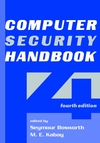| Chapter 6 – |
The Psychology of Computer Criminals |
Q. Campbell
David Kennedy, CISSP
Chapter Contents:
| |
6.1 |
|
Introduction
|
| |
6.1.1 |
|
Computer Crime Cost and Prevalence
|
| |
6.1.2 |
|
Recent Examples of Computer Crime
|
| |
6.2 |
|
Social Psychological Aspects of Computer Crime
|
| |
6.2.1 |
|
Anonymity, Aggression, and Computer Crime
|
| |
6.2.2 |
|
Social Presence and Computer Crime
|
| |
6.2.3 |
|
Deindividuation and Computer Crime
|
| |
6.2.4 |
|
Social Learning Theory of Computer Crime
|
| |
6.2.5 |
|
Individual Differences and Computer Criminals
|
| |
6.2.5.1 |
|
Narcissistic personalities and computer criminals
|
| |
6.2.5.2 |
|
Asperger syndrome and computer criminals
|
| |
6.2.5.3 |
|
Computer addiction and computer crime
|
| |
6.2.6 |
|
Ethics and Computer Crime
|
| |
6.3 |
|
Classifications of Computer Criminals
|
| |
6.3.1 |
|
Early Classification Theories of Computer Criminals
|
| |
6.3.2 |
|
Rogers's New Taxonomy of Computer Criminals
|
| |
6.3.3 |
|
Virus Creators
|
| |
6.4 |
|
Summary and Conclusions
|
| |
6.5 |
|
Notes
|
|
|
|

